 Boston Convention Center |
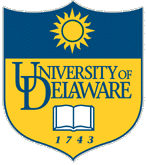 EB2013 EXPERIMENTAL BIOLOGY MEETINGS Boston, MA APRIL 20-24, 2013  |
 Boston
Night Skyline Boston
Night Skyline |
 Boston Convention Center |
 EB2013 EXPERIMENTAL BIOLOGY MEETINGS Boston, MA APRIL 20-24, 2013  |
 Boston
Night Skyline Boston
Night Skyline |
The University of Delaware group included four faculty and 9 undergraduates.
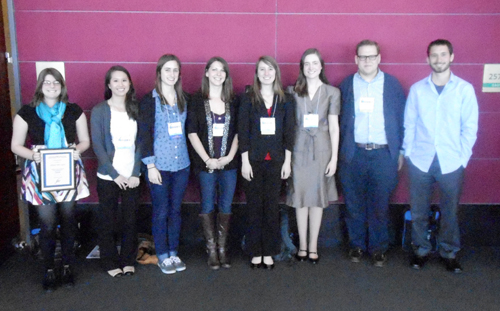 From left to right: Allison McCague, Christine Dang, Megan Dumas, Monica Pirigyi, Helen Schmidt, Laura Powell, Zachary March, and Nicholas Lombardi (Kahina Ghanem not shown) |
||
| Prof.
Hal White, Chem &Biochem Prof. Dave Usher, Biol. Sci. Prof. Seung Hong, Biol Sci Prof. Gary Laverty, Biol Sci |
Christine
Dang (Salil Lachke) Megan Dumas (Jia Song) Kahina Ghanem (Gary Laverty) Nicholas Lombardi (Erica Selva) Zachary March (David Colby) |
Allison
McCague (Erica Selva) Monica Pirigyi (Neal Zondlo) Laura Powell (Fidelma Boyd) Helen Schmidt (Eric Wommack) |
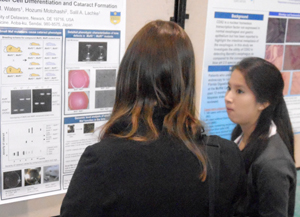 Christine
Dang
|
The MAF (musculoaponeurotic fibrosarcoma) gene family includes “large” and “small” MAF subgroups that encode bZIP transcriptional regulators. Although mutations in the large MAF gene “MAF” cause human congenital cataract, function of the small MAF genes MAFF, MAFK, and MAFG in the lens remains uncharacterized. iSyTE (integrated Systems Tool for Eye gene discovery), a tool that identifies genes associated with lens development and cataract, has predicted MAFG as a potential regulator in the lens. To test this prediction, we aimed to characterize mouse models carrying targeted mutant alleles of small Maf genes. In situ hybridization and Western blotting confirmed that Mafg mRNA and protein were expressed in the embryonic and adult mouse lens tissue. Furthermore, Mafg-/- ;Mafk+/- compound mutant mice exhibit lens defects and develop pre-senile cataract by age six months. Expression profiling by mouse Illumina microarrays on 2-month old Mafg-/-;Mafk+/- compound mutant and control lenses identified several differentially regulated genes in the lens. This analysis indicates that expression of the heat shock protein gene Hspb1 (also known as Hsp27) is significantly down-regulated in Mafg-/-;Mafk+/- compound mutant lenses. Together, these results suggest a functional role for the small Maf proteins MAFG and MAFK in maintenance of lens transparency. This research was funded by a Fight For Sight Foundation grant |
|
Basolateral Transport of HCO3- by Avian Renal Proximal Tubule Cells in CultureKahina Ghanem and Gary Laverty Department of Biological Sciences, University of Delaware, Newark, DE 19716 Bicarbonate
(HCO₃ˉ) is an important
component of acid/base regulation. Therefore, it is crucial to
understand the
mechanism of bicarbonate reabsorption in the kidney proximal tubule
(PT). In
mammals the reabsorption mechanism is well understood, but evidence
suggests
that birds may use a different mechanism. We hypothesize that in the
avian PT HCO3- crosses the luminal membrane in
ionic form, rather than as
CO2,
and that HCO3- ions then leave the basolateral
side via
an NBC1-like transporter, as in the mammalian PT. The experiments used
primary
cell cultures of chick PT and electrophysiological studies on these
monolayers
to measure currents (ISC) associated with ion transport.
Monolayers
were first stimulated with 1µM forskolin, which activated a
chloride secretory
current in the avian PT. This was followed by basolateral application
of 100 µM
DIDS, an inhibitor of NBC1. With bicarbonate in the bathing solution
DIDS
caused an increase in ISC of 6.25 + 1.565
µAmps/cm2
(n = 6 ), but only 2.30
+ 0.58 µAmps/cm2
(n = 5) in the
absence of bicarbonate. The increased ISC is consistent with
inhibition of electrogenic transport of HCO3-
ions via
the NBC1 transporter, and the decreased effect of DIDS in the nominal
absence
of bicarbonate further supports this. Additional studies support both
mRNA
expression and NBC1 protein expression (western blotting) in chick PT
cultures
and native tissue. Experiments are underway to test for an alternative
apical
transporter. |
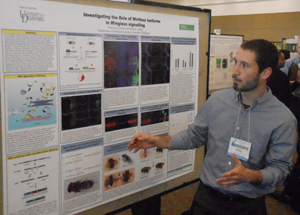 Nicholas Lombardi |
Investigating
the Role of Wntless isoforms in Wingless Signaling
Nicholas Lombardi and Erica Selva Department of Biological Sciences, University of Delaware, Newark, DE 19716 Wnts are secreted signaling
molecules that have essential functions in development and adult
homeostasis.
This family of proteins as well as the wnt signal transduction pathway
is
conserved from humans to invertebrates, including Drosophila.
Wingless (Wg) is the founding member of the Drosophila
Wnt family. Wg secretion
forms a morphogen gradient that elicits different signals in its short
and long-range
targets. Wntless (Wls) is a highly conserved multi-pass transmembrane
protein
that binds to Wg and escorts it through the secretion pathway. Wls
exists in
two isoforms within the cell designated Wls-A and Wls-B.
The goal of this research was to determine
the relative abundance of the two Wls isoforms, and determine the
difference in
their functions. PCR analysis results showed considerably higher levels
Wls-B
in the Drosophila imaginal wing discs.
Since, wlsB is predominate in the
wing disc I explored the phenotypic consequences of overexpressing each
isoform
in the posterior compartment of the developing wing disc.
Overexpression of
Wls-A in wing discs caused an increase in the distribution of Wg within
receiving cells and a corresponding expansion of Distalless, a
long-range
target of Wg signaling. In addition, the
overexpression of Wls-A showed a shift of Wg from the apical to basal
surface
of the wing disc. Conversely, overexpression of Wls-B showed a decrease
in Wg expression
in the posterior compartment and a shift of Wg toward to apical surface
and
away from the basal surface even more than is observed in wild type
tissue. Taken
together these results suggest that the cellular function of Wls A and
B differ.
The detailed molecular, cellular and developmental consequences of
these
differences will be examined in future experiments. |
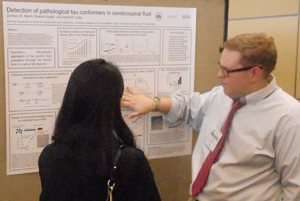 Zachary March Recipient of an ASBMB Undergraduate Travel Award |
Zachary M. March1,
Sharad Gupta1,2, and David W. Colby1
1Department of
Chemical and Biomolecular Engineering, University of Delaware
2Department of Biological Engineering, Indian Institute of Technology-Gandhinagar Misfolded tau is a
pathological hallmark of over 20 phenotypically distinct
neurodegenerative disorders, including Alzheimer's disease (AD).
Researchers are beginning to speculate that misfolded tau may spread
throughout the brain from a single locus like a prion; whether ornot
tau aggregates cross the cell membrane remains unclear. To investigate
the presence of misfolded tau in cerebrospinal fluid (CSF) of
patients with AD, we developed an amyloid seeding assay for tau. Our
findings indicate that misfolded tau molecules migrate in the CSF
through the extracellular space, supporting the possibility that
misfolded tau may spread through the brain like a prion. ZM supported
in part by an HHMI undergraduate research
|
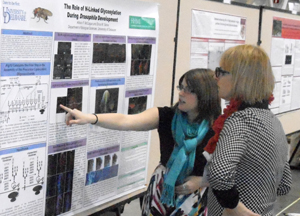 Allison McCague Recipient of Honorable Mention Award in The ASBMB Undergraduate poster Competition |
Dept. of Biological Sciences, Univ. of Delaware, Newark, DE 19716N-linked glycosylation is a key post-translational modification for many secretory pathway targeted proteins. Endoplasmic reticulum glycosyltranferases construct a 14-sugar precursor on a dolichol carrier, which is transferred to protein consensus sites. alg9 and alg10 N-glycosylation mutants were used to examine the role of this modification during Drosophila development. alg10 encodes the enzyme catalyzing terminal glucose addition to the sugar-precursor prior to transfer, while alg9 encodes an enzyme acting five steps earlier. In embryos, loss of alg9 and alg10 caused severe and pleotrophic defects. Central nervous system (CNS) neurons were specified in both alg9 and alg10 embryos. alg10 loss disrupted axon pathfinding, while alg9 embryos lacked mature neurons. Drosophila eye development in the absence of alg9 and alg10 yielded small rough adult eyes, but alg9 eyes were more severe. Examination of molecular markers in alg9 and alg10 late 3rd instar eye imaginal discs suggested adult small rough adult eyes might be due to neuronal apoptosis. These eye discs also showed defects in axon pathfinding, as shown by the loss of Bolwig’s nerve and disrupted axon tracks. These results suggest loss of alg10 may disrupt the maturation of a subset of N-glycoproteins, since alg9, which acts earlier, has more severe developmental defects. Funding sources: UD Undergrad Research Program, NSF and HHMI
|
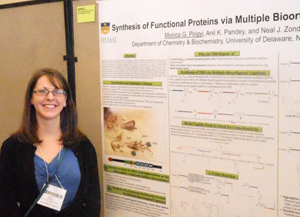 Monica
Pirigyi
|
Synthesis of
Functional Proteins via Bioconjugation
Monica Pirigyi and Neal Zondlo Department of Chemistry and Biochemistry, University of Delaware Large protein
synthesis is a present day
biochemical challenge. Proteins can efficiently be expressed from
various
sources; however, post-translational modifications to introduce specific phosphorylation and
spectroscopic labels can be challenging. One promising mechanism in
creating these large, functional proteins is bioconjugation. This work
is directed toward microtubule binding studies to elucidate
the mechanism of tau aggregation in Alzheimer’s Disease. Peptides from the
tubulin-binding domain of Tau were synthesized on an automated peptide
synthesizer and modifications were conducted, on both solid and solution phase,
to allow incorporation of specific phosphorylation events and multiple
bioorthogonal functionalities. Peptides were modified and peptideconjugation reactions
were conducted. To elucidate the efficiency of these bioconjugation
reactions we have used model peptides and demonstrated clean, efficient
conversions in aqueous solutions. Further, we are utilizing these tools to synthesize
proteins with multiple tubulin-binding domain repeats and to study their
ability to bind, polymerize, and depolymerize microtubules in both their
nonphosphorylated and phosphorylated states.
|
|
Regulation
of the Osmotic Tolerance Response in the Halophile Vibrio
parahaemolyticus
Laura Powell and Fidelma Boyd Dept. of Biological Sciences, Univ. of Delaware, Newark, DE 19716Vibrio
parahaemolyticus
is a
Gram-negative, rod-shaped halophile bacterium present in marine
environments
worldwide. The bacterium has an absolute
requirement for NaCl and can grow in up to 10% NaCl in complex media. Vibrio parahaemolyticus is also a
pathogen of humans that causes gastroenteritis usually through the
consumption
of raw oysters. The V.
parahaemolyticus genome contains a large number of compatible
solute
synthesis and transporter systems that allows it to grow in high NaCl
concentrations. How these multiple
systems and osmotic tolerance in general are regulated is unknown. In this study, we investigated the regulation
of osmotic tolerance by examining the homologue of the EnvZ/OmpR
two-component
signal transduction system, vp0155 and vp0154.
In Escherichia coli EnvZ/OmpR
regulates more than 100 genes, and
significantly influences cell growth,
metabolism, and motility.
For example, in response to osmotic
stress the
EnvZ/OmpR
system has been shown to
regulate expression of outer membrane proteins (OMPs).
We examine
its role in V.
parahaemolyticus by deleting a portion of vp0155,
an envZ
homologue and vp0154, the ompR
homologue. Through splicing by overlap
extension (SOE) PCR and homologous recombination, a deletion was
created in both envZ and ompR. Through
homologous
recombination and selection, mutants harboring in-frame deletions in
the envZ and ompR genes were
created,
and confirmed by PCR and sequencing. We
describe the effects of our knockout mutations in envZ/ompR
in response to NaCl, acid, and alkaline stresses as well
as swimming and swarming motility and OMPs and type VI secretion system
expression. Research supported by a grant from the Howard Hughes
Medical
Institute. |
|
Helen
F Schmidt1, Eric G Sakowski1, Shannon
J Williamson2, Shawn W Polson1,
K
Eric Wommack1
1University of Delaware, Newark, DE, 2Lake Pend Oreille Waterkeeper, Sandpoint, ID
Despite decades of investigation, we know little of the predominant biological characteristics of aquatic viruses that drive the rapid turnover of abundant virioplankton assemblages. DNA polymerases are essential to replication and thus enable connections between diversity and an important biological feature of viruses. Novel DNA polymerases, containing all critical functional domains, were common within dsDNA and ssDNA virioplankton metagenomic libraries. Finding DNA polymerases in ssDNA libraries was unexpected, as these genes have not been observed within ssDNA viruses. Comparison of PCR-amplified environmental DNA pol sequences with virioplankton metagenome sequences showed that the majority of the metagenomic polymerase sequences grouped away from previously identified groups of viral DNA polymerases forming a new group that included siphoviruses. An F762L amino acid substitution was observed within this dominant clade. Phylogenetic analysis of phages with known life cycles indicates that an F/Y762L substitution is a strong predictor of lysogeny, indicating that slower-replicating, lytic or lysogenic phage populations may predominate within the virioplankton and shape the influence of viruses on marine biogeochemical cycles. This work was funded by the HHMI Undergraduate Science Education program the NSF Microbial Genome Sequencing Program, the Gordon & Betty Moore Foundation, and Delaware EPSCoR. |
 Boston Daytime Skyline |
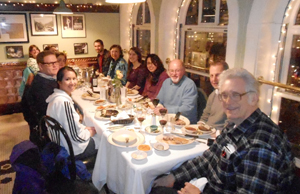 Dinner at Durgin Park |
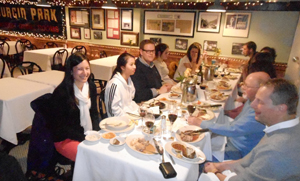 Dinner at Durgin Park. UD Alum Courtney Ngai at left. |
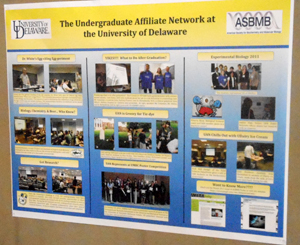 UD ASBMB-Undergraduate Affiliate's Activity Poster for 2012-2013. |
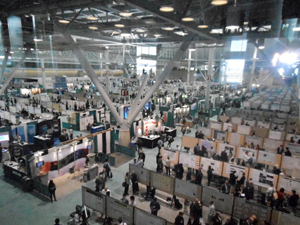 Thousands of posters on the Boston Convention Center main floor, |
 Welcome sign outside the Boston Convention Center two days after the end of the Marathon Bommer capture. |
The trip to the Experimental Biology
2013 Meetings
in Boston was organized by the University of Delaware HHMI
Undergraduate
Science Education Program with additional support from travel grants
from
the American
Society for Biochemistry and Molecular Biology. The HHMI
Undergradaute Science Education Program, Charles Peter White
Fund, Undergraduate Research
Program, NIH, NSF, supported
research by individual students.